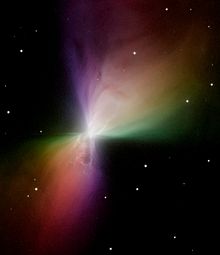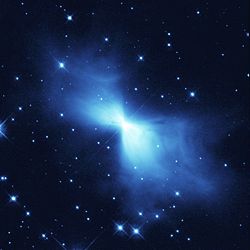Mlhovina Bumerang

| Mlhovina Bumerang | |
|---|---|
 Mlhovina Bumerang (NASA/ESA) | |
| Pozorovací údaje (Ekvinokcium J2000,0) | |
| Typ | protoplanetární mlhovina |
| Datum objevu | 1979 |
| Rektascenze | 12h 44m 45s |
| Deklinace | -54° 31' 11" |
| Souhvězdí | Kentaur (lat. Cen) |
| Zdánlivá magnituda (V) | ? |
| Vzdálenost | 5 000 ly |
| Označení v katalozích | |
| 2MASS | 2MASS J12444609-5431133 |
| IRAS | IRAS 12419-5414 |
| Jiná označení | PGC 3074547 |
| (V) – měření provedena ve viditelném světle | |
| Některá data mohou pocházet z datové položky. | |
Mlhovina Bumerang je protoplanetární mlhovina ve velmi rané fázi vývoje, ležící zhruba 5 000 světelných let od sluneční soustavy. Nalézá se v jižním souhvězdí Kentaura. Jde o nejchladnější známé místo ve vesmíru.[1] Tento vesmírný objekt byl objeven roku 1979 v rámci prohlídky jižní oblohy a dostal označení ESO 172-07. Že jde o mlhovinu si jako první uvědomili astronomové Gary Wegner a Ian Glass z Jihoafrické astronomické observatoře, kteří ji pozorovali ještě téhož roku. Roku 1980 ji pozorovali Keith Taylor a Mike Scarrott na observatoři Siding Spring v australském městě Coonabarabran, a objevili, že mlhovina sestává ze dvou výtrysků plynu směřujících pryč z centrálního objektu. Podle jejího pozorovaného tvaru jí dali její současné jméno.[2][3]
Plyny unikají z centrální hvězdy rychlostí kolem 150 km/s, a proto se molekuly ochlazují na mlhovinový plyn s teplotou těsně nad absolutní nulou, je tedy chladnější než záření vesmírného pozadí, a to z něj činí nejchladnější známou oblast ve vesmíru. Oxid uhelnatý v mlhovině pohlcuje reliktní záření, takže teplota tam musí být nižší než -271 °C.[4] Mlhovina svítí světlem z centrální hvězdy, odraženým od odvrženého prachu. Ročně hvězda odvrhuje asi jednu tisícinu své hmotnosti.[5]
Astrofyzici Raghvendra Sahai a Lars-Ake Nyman vypozorovali v roce 1995 díky radioteleskopu ESO v Chile, že teplota v mlhovině je okolo 1 kelvinu, tedy jeden stupeň nad absolutní nulou. Podle vědců je centrem mlhoviny bílý trpaslík o stejné hmotnosti jako Slunce a velikosti Země.[4]
Odkazy
Související články
Reference
- ↑ A Beautiful Boomerang Nebula [online]. Astronomy Picture of the Day [cit. 2012-01-12]. Dostupné online. (anglicky)
- ↑ KRUSZELNICKI, Karl S. Coldest Place in the Universe 2. AABC Science [online]. 2003-9-25. Dostupné online. (anglicky)
- ↑ The Boomerang Nebula - the coolest place in the Universe? [online]. European Space Agency, 2003-02-20 [cit. 2012-01-13]. Dostupné v archivu pořízeném dne 2012-03-09. (anglicky)
- ↑ a b Malcom W. Browne. The Chilliest of Stars [online]. New York Times, 1997-06-24 [cit. 2012-01-12]. Dostupné online. (anglicky)
- ↑ ČEMAN, Róbert; PITTICH, Eduard. Vesmír 2 Hvězdy - Galaxie. Bratislava: MAPA Slovakia, 2003. ISBN 80-8067-075-7.
Externí odkazy
 Obrázky, zvuky či videa k tématu Mlhovina Bumerang na Wikimedia Commons
Obrázky, zvuky či videa k tématu Mlhovina Bumerang na Wikimedia Commons - (anglicky) Informace na ESA/Hubble-Boomerang Nebula
Média použitá na této stránce
The Boomerang Nebula is a young planetary nebula and the coldest object found in the Universe so far. The NASA/ESA Hubble Space Telescope image is yet another example of how Hubble's sharp eye reveals surprising details in celestial objects.
This NASA/ESA Hubble Space Telescope image shows a young planetary nebula known (rather curiously) as the Boomerang Nebula. It is in the constellation of Centaurus, 5000 light-years from Earth. Planetary nebulae form around a bright, central star when it expels gas in the last stages of its life.
The Boomerang Nebula is one of the Universe's peculiar places. In 1995, using the 15-metre Swedish ESO Submillimetre Telescope in Chile, astronomers Sahai and Nyman revealed that it is the coldest place in the Universe found so far. With a temperature of -272C, it is only 1 degree warmer than absolute zero (the lowest limit for all temperatures). Even the -270C background glow from the Big Bang is warmer than this nebula. It is the only object found so far that has a temperature lower than the background radiation.
Keith Taylor and Mike Scarrott called it the Boomerang Nebula in 1980 after observing it with a large ground-based telescope in Australia. Unable to see the detail that only Hubble can reveal, the astronomers saw merely a slight asymmetry in the nebula's lobes suggesting a curved shape like a boomerang. The high-resolution Hubble images indicate that 'the Bow tie Nebula' would perhaps have been a better name.
The Hubble telescope took this image in 1998. It shows faint arcs and ghostly filaments embedded within the diffuse gas of the nebula's smooth 'bow tie' lobes. The diffuse bow-tie shape of this nebula makes it quite different from other observed planetary nebulae, which normally have lobes that look more like 'bubbles' blown in the gas. However, the Boomerang Nebula is so young that it may not have had time to develop these structures. Why planetary nebulae have so many different shapes is still a mystery.
The general bow-tie shape of the Boomerang appears to have been created by a very fierce 500 000 kilometre-per-hour wind blowing ultracold gas away from the dying central star. The star has been losing as much as one-thousandth of a solar mass of material per year for 1500 years. This is 10-100 times more than in other similar objects. The rapid expansion of the nebula has enabled it to become the coldest known region in the Universe.
The image was exposed for 1000 seconds through a green-yellow filter. The light in the image comes from starlight from the central star reflected by dust particles.Image of Boomerang nebula taken by Hubble Space Telescope

